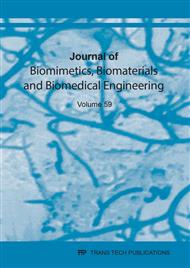[1]
I. Khan, K. Saeed, I. Khan, Nanoparticles: Properties, applications and toxicities. Arabian Journal of Chemistry 12(7) (2021) 908-931.
DOI: 10.1016/j.arabjc.2017.05.011
Google Scholar
[2]
M. Khatami, R.S. Varma, N. Zafarnia, H. Yaghoobi, M. Sarani, V.G. Kumar, Applications of green synthesized Ag, ZnO and Ag/ZnO nanoparticles for making clinical antimicrobial wound-healing bandages. Sustainable Chemistry and Pharmacy 10 (2018) 9–15.
DOI: 10.1016/j.scp.2018.08.001
Google Scholar
[3]
V. Tiwari, N. Mishra, K. Gadani, P.S. Solanki, N.A. Shah, M. Tiwari, Mechanism of anti-bacterial activity of Zinc oxide nanoparticle against carbapenem-resistant Acinetobacter baumannii. Frontiers in Microbiology 1218(9) (2018) 1-10.
DOI: 10.3389/fmicb.2018.01218
Google Scholar
[4]
M. Ebadi, M.R. Zolfaghari, S.S. Aghaei, M. Zargar, M. Shafiei, H.S. Zahiric, K.A. Noghabi, A bio-inspired strategy for the synthesis of zinc oxide nanoparticles (ZnO NPs) using the cell extract of cyanobacterium Nostoc sp. EA03: from biological function to toxicity evaluation. RSC Advances 9 (2019) 23508–23525.
DOI: 10.1039/c9ra03962g
Google Scholar
[5]
L. Castillo-Henríquez, K. Alfaro-Aguilar, J. Ugalde-Álvarez, L. Vega-Fernández, G. Montes de Oca-Vásquez, J.R. Vega-Baudrit, Green synthesis of gold and silver nanoparticles from plant extracts and their possible applications as antimicrobial agents in the agricultural area. Nanomaterials 10 (2020) 1763.
DOI: 10.3390/nano10091763
Google Scholar
[6]
J.O. Primo, C. Bittencourt, S. Acosta, A. Sierra-Castillo, J.F. Colomer, S. Jaerger, V.C. Teixeira, F.J. Anaissi, Synthesis of zinc oxide nanoparticles by ecofriendly routes: Adsorbent for copper removal from wastewater. Frontiers in Chemistry 8 (2020) 571790.
DOI: 10.3389/fchem.2020.571790
Google Scholar
[7]
T.U.D. Thi, T.T. Nguyen, Y.D. Thi, K.H.T. Thi, B.T. Phan, K.N. Pham, Green synthesis of ZnO nanoparticles using orange fruit peel extract for antibacterial activities. RSC Advances 10 (2020) 23899–23907.
DOI: 10.1039/d0ra04926c
Google Scholar
[8]
N.A. Al-Dhabi, M.V. Arasu, Environmentally friendly green approach for the production of zinc oxide nanoparticles and their anti-fungal, ovicidal, and larvicidal properties. Nanomaterials 8 (2018) 500.
DOI: 10.3390/nano8070500
Google Scholar
[9]
R.K. Shah, F. Boruah, N. Parween, Synthesis and characterization of ZnO nanoparticles using leaf extract of Camelia sinensis and evaluation of their antimicrobial efficacy. International Journal of Current Microbiology and Applied Sciences 4 (2019) 444–450.
Google Scholar
[10]
M. Sánchez, E. González-Burgos, I. Iglesias, M.P. Gómez-Serranillos, Pharmacological update properties of aloe vera and its major active constituents. Molecules 25(6) (2020) 1324.
DOI: 10.3390/molecules25061324
Google Scholar
[11]
E.H. Kaparakou, C.D. Kanakis, M. Gerogianni, M. Maniati, K. Vekrellis, E. Skotti, P.A. Tarantilis, Quantitative determination of aloin, antioxidant activity, and toxicity of Aloe vera leaf gel products from Greece. Journal of the Science of Food and Agriculture 101(2) (2021) 414-423.
DOI: 10.1002/jsfa.10650
Google Scholar
[12]
M.A. Abdul Talib, N.A. Mohd Said, N.F. Nor Azeme, M.S. Ghazali, N.A. Masdor, F. Salam, K. Ramachandran, Specificity of PCR primers for identification of Xanthomonas oryzae pv. oryzae and Xanthomonas oryzae pv. oryzicola with ten plant bacterial pathogens. Transactions of the Malaysian Society of Plant Physiology 25(1) (2017) 244-246.
DOI: 10.3390/pathogens9030187
Google Scholar
[13]
W. Lu, L. Pan, H. Zhao, Y. Jia, Y. Wang, X. Yu, X. Wang, Molecular detection of Xanthomonas oryzae pv. oryzae, Xanthomonas oryzae pv. oryzicola and Burkholderia glumae in infected rice seeds and leaves. The Crop Journal 2(6) (2014) 398 – 406.
DOI: 10.1016/j.cj.2014.06.005
Google Scholar
[14]
G. Marslin, K. Siram, Q. Maqbool, R.K. Selvakesavan, D. Kruszka, P. Kachlicki, G. Franklin, Secondary metabolites in the green synthesis of metallic nanoparticles. Materials 11(6) (2018) 940.
DOI: 10.3390/ma11060940
Google Scholar
[15]
A. Aldalbahi, S. Alterary, R.A.A. Almoghim, M.A. Awad, N.S. Aldosari, S.F. Alghannam, A.N. Alabdan, S. Alharbi, B.A. Mohammed Alateeq, A.A. Al Mohsen, M.A. Alkathiri, R.A. Alrashed, Greener synthesis of zinc oxide nanoparticles: Characterization and multifaceted applications. Molecules 25 (2020) 4198-4212.
DOI: 10.3390/molecules25184198
Google Scholar
[16]
Y.W. He, X.Q. Cao, A.R. Poplawsky, Chemical structure, biological roles, biosynthesis and regulation of yellow xanthomonadin pigments in the phytopathogenic genus Xanthomonas. Molecular Plant-Microbe Interactions 33(5) (2020) 705-714.
DOI: 10.1094/mpmi-11-19-0326-cr
Google Scholar
[17]
K.M. Reddy, K. Feris, J. Bell, D.G. Wingett, C. Hanley, A. Punnoose, Selective toxicity of zinc oxide nanoparticles to prokaryotic and eukaryotic systems. Applied Physics Letters 90(21) (2007) 213902.
DOI: 10.1063/1.2742324
Google Scholar
[18]
Y.N. Slavin, J. Asnis, U.O. Häfeli, H. Bach, Metal nanoparticles: Understanding the mechanisms behind antibacterial activity. Journal of Nanobiotechnology 15 (2017) 65.
DOI: 10.1186/s12951-017-0308-z
Google Scholar
[19]
K.R. Raghupathi, R.T. Koodali, A.C. Manna, Size-dependent bacterial growth inhibition and mechanism of antibacterial activity of zinc oxide nanoparticles. Langmuir 27 (2011) 4020–4028.
DOI: 10.1021/la104825u
Google Scholar
[20]
Q.U.A. Naqvi, A. Kanwal, S. Qaseem, M. Naeem, S.R. Ali, M. Shaffique, M. Maqbool, Size-dependent inhibition of bacterial growth by chemically engineered spherical ZnO nanoparticles. Journal of Biological Physics 45 (2019) 147–159.
DOI: 10.1007/s10867-019-9520-4
Google Scholar
[21]
I. Kahramanoğlu, C.Y. Chen, J.Y. Chen, C.P. Wan, Chemical constituents, antimicrobial activity and food preservative characteristics of Aloe vera gel. Agronomy 9 (2019) 831.
DOI: 10.3390/agronomy9120831
Google Scholar
[22]
M.K. Hayat, T. Kumar, N. Ahmad, S.A. Jan, W. Sajjad, S. Faisal, B.X. Gao, K. Khan, Z.U. Rahman, B.H. Abbas, In vitro antimicrobial activity of Aloe vera L. extracts against pathogenic bacteria and fungi. Mycopath 14(1) (2016) 21-27.
Google Scholar
[23]
V.A. Ferro, F. Bradbury, P. Cameron, E. Shakir, S.R. Rahman, W.H. Stimson, In vitro susceptibilities of Shigella flexneri and Streptococcus pyogenes to inner gel of Aloe barbadensis Miller. Antimicrobial Agents and Chemotherapy 47(3) (2003) 1137-1139.
DOI: 10.1128/aac.47.3.1137-1139.2003
Google Scholar
[24]
X.L. Chen, S.F. Wei, Q. Yan, F.K. Huang, Z.F. Ma, R.F. Li, Z.L. Chen, W.H. Yan, K.H. Li, Virulence and DNA fingerprinting analysis of Xanthomonas oryzae pv. oryzae identify a new pathotype in Guangxi, South China. Journal of Basic Microbiology 59(11) (2019) 1082-1091.
DOI: 10.1002/jobm.201900354
Google Scholar
[25]
A. Saad, H. Habibuddin, Pathotypes and virulence of Xanthomonas oryzae causing bacterial blight disease of rice in Peninsular Malaysia. Journal of Tropical Agriculture and Food Science 38(2) (2010) 257– 266.
Google Scholar


